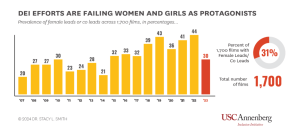Barbie may have rescued the box office in 2023, but she could not tip the balance for representation of women in films.
Even as state legislatures consider restricting or eliminating DEI initiatives at public institutions, the percentage of women, women of color and women 45+ in films in 2023 has plummeted to lows not seen in almost a decade, according to the results of a study released this morning by the USC Annenberg Inclusion Initiative. In fact, those percentages are the worst since 2014, despite Barbie.
“It is a difficult lesson but one that must be restated: One film does not represent progress across the industry and cannot bear the burden of lifting the industry to inclusion,” wrote the study’s authors Katherine L. Neff, Dr. Stacy L. Smith & Dr. Katherine Pieper.
USC Annenberg analyzed “the gender identity, racial/ethnicity, and age of leads/co leads across the 100 top-grossing films from 2007 to 2023,” which encompassed more than 1,700 titles in all.
“The findings are awful,” wrote Neff, Dr. Smith & Dr. Katherine Pieper. “Despite posturing, the legacy studios have dealt little or reversed course on inclusion in popular films.”
They stress that one film, even if it’s the year’s biggest, cannot make up for the relative dirth of representation in the remaining offerings.
“The results this year point to an industry grown apathetic about efforts surrounding diversity and inclusion. While it is critical to celebrate the achievements of significant films like Barbie, there must be more than one or a handful of films that reflect the experiences of women and people of color each year. Until the industry stops hiding behind a single exemplar, change will remain elusive.”
According to the authors, only 30 of the 100 top films of 2023 featured a female-identified actor as a lead/co lead at the center of the plot. That percentage (30%) was substantially lower than the 44% tallied in 2022. Yet, females represent more than 50% of the U.S. population and half of the movie going audience.
Age-wise, only three solo-led or co-led movies last year featured a woman 45 years of age or older at the time of theatrical release. They are Cocaine Bear (Keri Russell), My Big Fat Greek Wedding 3 (Nia Vardalos) and Magic Mike’s Last Dance (Salma Hayek). In fact, for every 1 film led/co led by an older woman, there
were 10-plus films led/co led by an older man.
The three films that featured women 45 years of age or older as leads/coleads in 2023 was significantly lower than the 10 tallied just one year earlier, in 2022.
The percentage of films with leads/co leads of color significantly increased from 31 titles in 2022 to 37
titles in 2023. That’s a big improvement over 2007, when it was 13%, but still lower than the percentage of the underrepresented people nationally, at 41%. The good news is that two studios got very close to that number in 2023. See below.
The breakdown of representation by distributor female leads/co leads is as follows:
Walt Disney Studios 46.1%
Paramount Pictures 44.4%
Warner Bros. Pictures 38.5%
Universal Pictures 21.1%
Lionsgate 20%
The breakdown of representation by distributor for racial/ethnic leads/co leads is as follows:
Walt Disney 38.5%
Warner Bros. Pictures 38.5%
Sony Pictures Entertainment 30.8%
Paramount Pictures 22.2%
Lionsgate 20%
The study’s authors offered the following advice to studio boffins: “It is time for experts to guide their decision making rather than rely on internal mechanisms for change,” wrote the authors.
And hire more women behind the camera.
Why? The numbers would seem to indicate a relationship between who is working behind the camera and who is seen in front of it.
Of the 30 films with a girl or woman in a lead or co-lead role, 36.7% were directed by a woman and
63.3% were directed by a man. In contrast, of the films that did not have a girl/woman in a lead/co lead role, only 4.3% were directed by women. For women directors, the likelihood of
Roughly half (51.3%) of the films with an underrepresented lead/co lead had an underrepresented director, while 48.7% did not. Underrepresented directors were much less likely to work on films with leads/co leads who were not underrepresented. Less than 10% of the top-grossing films without an underrepresented lead had an underrepresented director while 90.5% had a white director.
“As with gender, the identity of the lead is connected to the identity of the director,” observed the authors.

